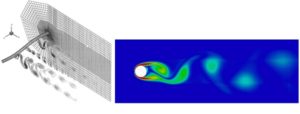SUNNYVALE, Calif., Oct. 21, 2019 – UberCloud, known for its containerized engineering workflows in the cloud, and for its community cloud projects leading to engineering cloud projects, today announces the publication of its new Compendium of Engineering Cloud Case Studies.
Over the past two years we have seen tremendous growth of the interest in cloud computing in the engineering community. According to Hyperion, over 70% of HPC sites run some simulation jobs in public clouds today, up from 13% in 2011, and over 10% of all HPC jobs are now running in clouds like Microsoft Azure, Amazon AWS, and Google Cloud. Although the cloud ‘on-boarding’ process is quite well understood, some challenges still exist, like on-demand ISV software licenses for the cloud, multi-gigabyte data transfer, security concerns, lack of cloud expertise, and potentially losing control over your assets in the cloud.
“In 2015, based on our experience gained from the previous 100+ cloud experiments, we reached an important milestone when we introduced novel software container technology based on Docker containers which we applied to complex engineering CAE workflows,” said Wolfgang Gentzsch, President and co-founder of UberCloud. “Use of these HPC containers dramatically shortened cloud on-boarding times.” Today, major cloud hurdles are well understood and have mostly been resolved, and access to and use of cloud resources became as easy as the use of in-house desktop systems.
Our new 2019 annual compendium describes 13 technical computing applications in the cloud. Like its predecessors, this year’s edition draws from a select group of projects undertaken as part of the UberCloud Experiment, sponsored again by Hewlett Packard Enterprise, Intel, HPCwire, and Digital Engineering Magazine. (A more extended version of this announcement appeared in the Digital Engineering Magazine.) In the following we have briefly summarized three CAE cloud experiments to demonstrate the power of cloud for engineering and scientific applications.
Fluid-Structure Interaction of Artificial Aortic Heart Valves in the Advania Data Centers Cloud

This cloud experiment has been performed by Deepanshu Sodhani, R&D Project Manager for Engineering, Modeling and Design at enmodes GmbH, a worldwide service provider in the field of medical technology. Enmodes has been supported by Dassault Systèmes, Capvidia/FlowVision, Advania Data Centers, and UberCloud, and sponsored by Hewlett Packard Enterprise and Intel. It is based on the development of Dassault’s Living Heart Model applied to Fluid-Structure Interaction of Artificial Aortic Heart Valves.
The FSI simulation model was computed using Abaqus as the structural solver and FlowVision from as the fluid solver, both codes coupled in an UberCloud HPC container. Scalability of the application up to 64 CPU cores has been studied with increasing number of cores. The model was further evaluated to predict the risk parameters to understand the correlation between the level of fidelity and resulting accuracy by carrying out a mesh convergence study over three mesh densities. The valve was modelled using 90000 finite elements, whereas the fluid domain was modelled using approx. 300,000, 900,000 and 2,700,000 finite volume cells.
Migrating Engineering Workloads to the Azure Cloud
FLSmidth is a leading supplier of engineering, equipment and service solutions to customers in mining and cement industries. In September 2018, Sam Zakrzewski from FLSmidth approached UberCloud to perform an extensive Proof of Concept; the project team designed and configure FLSmidth’s Azure cloud environment and benchmarked applications to understand engineering simulation usage of Cloud HPC resources and related CAE workflows. Multi-node runs showed excellent scalability. The ability to scale up to large number of resources enabled FLSmidth to run multiple jobs simultaneously reducing multi-job duration and significantly increasing HPC throughput for engineers.

The FLSmidth engineering team, which is distributed between locations in Copenhagen, India, South Africa, and Brazil, drafted a list of requirements of moving different simulation scenarios using ANSYS CFX and ESSS Rocky to Azure. FLSmidth currently has its own on-premises Intel Haswell-based HPE cluster with 512 cores and Infiniband FDR. In the next step, it wishes to increase its user base and upgrade the on-premises environment with cloud bursting for mission-critical applications in CFD (multi-phase, combustion) using ANSYS CFX and Fluent, STAR CCM+, and ANSYS Mechanical (static, thermal, modal, fatigue).
Overhead Electrical Power Lines Lifespan Assessment in Preventive Maintenance in the Advania Data Center Cloud
Réseau de Transport d’Électricité (RTE) is the operator of the high voltage electricity transmission network in France. With more than 100,000 kilometers of high voltage overhead lines, this network is the largest in Europe. Management of these physical assets is a top priority. The challenges are particularly high in the field of overhead conductors, as the costs of replacing them will reach several hundred million Euros annually in the coming years. Preventive Maintenance plays a major role in providing uninterrupted services and reducing outages and costs due to equipment fatigue and failures.

In this project, RTE’s Fikri Hafid and Lei Zhang studied vortex-induced vibrations of overhead power lines for a better estimation of the lifespan of overhead lines. We analyzed lift and drag created by low wind speeds, and line vibrations due to cyclic stresses which cause fatigue failure of the wires. CFD Code_Saturne has been used simulating the airflow around the overhead lines, and the overall line dynamics captured by an in-house solid solver (FEM). The code coupling was used to determine interaction between the wind and the power line.
The final simulation ran on a 1000-core cluster on the Advania Data Centers cloud, simulating a 325 m overhead line. For reaching near-steady vibrations after about 55,000 computational timesteps the simulation took 431 hours or 18 days. The 55,000 computational timesteps correspond to a physical time of 55 seconds until the vibrations become stable.
About UberCloud
UberCloud enables engineers and scientists to discover, try, and buy CAE as a Service, on demand, on a pay-per-use basis. Novel CAE software containers make engineering simulations in the cloud as straight-forward as on the desktop workstation, giving the engineer full control over all hardware and software resources in the cloud, thereby dramatically increasing productivity, insight, and product quality. Learn more about UberCloud at: http://www.TheUberCloud.com.
Source: UberCloud




























































